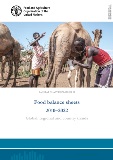Highlights
Food balance sheets 2010–2022. Global, regional and country trends
New FAOSTAT data release

19/07/2024
The Statistics Division of the Food and Agriculture Organization of the United Nations (FAO) compiles Food Balance Sheet (FBS) statistics for 189 countries, which present a comprehensive picture of the agrifood situation of a country in a specified reference period, showing the pattern of a country's food supply and utilizations.
The new release of the 2022 FBS data comprises time series from 2010 to 2022.
Main findings:
- Global food supply, measured by per capita dietary energy supply, increased by 5 percent between 2010 and 2022, to 2 985 kcal/cap/day.
- The highest DES in 2022 was recorded in Europe and the Americas, with Oceania as the third highest. The fastest increase in the DES between 2010 and 2022 took place in Asia, while in Africa the DES remained the lowest throughout the period, with minor fluctuations.
- Between 2021 and 2022, the most severe decreases in caloric availability at the country level were recorded in Haiti, Ukraine and Yemen.
- Meat products represented 21 percent of total protein supply globally in 2022. Poultry is the largest protein source (41 percent of the total), followed by pigmeat (31 percent) and bovine meat (21 percent), while mutton, goat, and other types of meat (such as horse, rabbit, and camel meat) contribute 5 percent or less.

